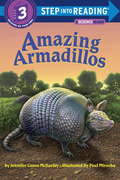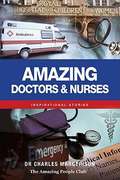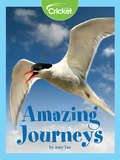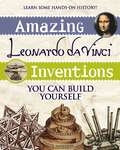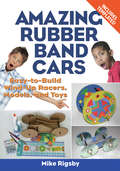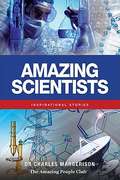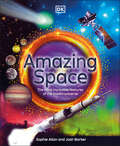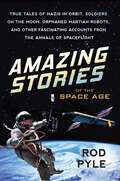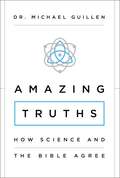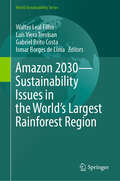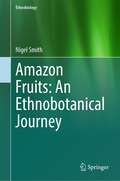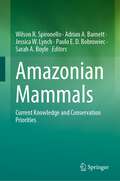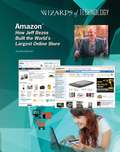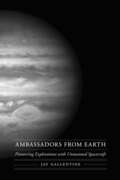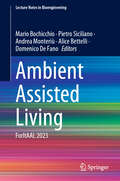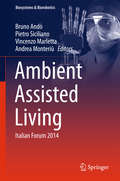- Table View
- List View
Amazing Arctic and Antarctic Projects
by Steven Weinberg Carmella Van VleetAmazing Arctic & Antarctic Projects You Can Build Yourself explores the Earth's polar regions with 25 interactive projects, activities, and experiments. Kids ages 9 and up will discover that the coldest places on Earth hold fascinating scientific wonders and mysteries. Historical facts and anecdotes, biographies, and fascinating trivia support the fun projects to teach young readers about the harsh polar climate, immense Arctic tundra, magical Northern Lights, vast glaciers, ancient frozen lakes, remarkable animals and plants, brave explorers, innovative people who live and work at the top and bottom of the world, and the vital importance of conservation. With Amazing Arctic & Antarctic Projects You Can Build Yourself kids will gain an appreciation for the exciting and extraordinary polar environments.
Amazing Armadillos (Step into Reading)
by Paul Mirocha Jennifer MckerleyReading on your own Armadillos may look funny, move oh-so-slowly, and smell a little stinky but mostly they are extraordinary! For example, they can jump three feet in the air to scare away any predators (especially the human variety), they can hold their breath underwater for 10 minutes, and they've been known to eat 40,000 bugs in a single meal.Amazing Armadillos follows a female armadillo as she forages for food, builds a home, and prepares for the birth of her baby pups. It is perfect for newly independent readers who love to learn fun, quirky, and cool facts about amazing animals, like the armadillo.
Amazing Doctors and Nurses
by Charles MargerisonEver wondered who developed insulin? Or, who completed the first heart transplant? Explore the lives of some of most amazing doctors and nurses. Gain an insight into the lives they led and the challenges they faced. We have all relied on doctors and nurses at various points during our lives. However, the amazing stories behind so many important and influential achievements remain unknown. This book explores how doctors and nurses have developed their remarkable skills and methods to help patients, supported by researchers in many fields.Explore the life stories of an amazing range of characters including Florence Nightingale, Elizabeth Blackwell, Ignaz Semmelweis and Che Guevara. These people paved the way for modern medicine and saved countless lives by advancing the boundaries of treatment. The life stories come back to life through in a new story format called a BioView®. It is as if each of the doctors and nurses has returned through time to tell the story of their life and their amazing achievements.What is a BioView®? A BioView® is a short biographical story, similar to an interview, about an amazing person. The stories can be read in around ten minutes. They provide an easy way of learning about people who made major contributions to our world. The unique format and flow enables each person's story to come alive, as if it is being personally told to you and reflects their interests, emotions and passions. These are unique life stories that can provide you with inspiration in your own life.Visit www.amazingpeopleclub.com to explore this exciting range ofbooks and audio resources.
Amazing Inventions (Comic Strip Science Adventures #3)
by Paul MasonAn entertaining collection of comic strip stories uncovering the stories around some incredible inventions.Discover how the Wright Brothers got into flying planes, the science behind the lightbulb, some incredible child inventors and more. This book is sure to entertain children, while giving them an insight into the many challenges and rivalries behind scientific achievements and how scientists learn from mistakes. It is produced by the same team as Comic Strip Science with hilarious comic strips illustrated by award-winning artist Jess Bradley and written by Paul Mason, who is well known for making science learning fun. Key science concepts are pulled out in more depth in feature spreads. The book has a specialist text consulant, science educator Peter Riley.Comic Strip Science Adventures is a series of comic books that are perfect for young scientists aged 7 plus. Each book has specialist subject consultants. Titles in the series: Digging for Dinosaurs, Exploring Space, Medical Marvels, Amazing Inventions.
Amazing Journeys
by Amy TaoWhy do some animals migrate? In this story, readers will learn about the journeys of animals to find more food or to seek better weather. Six animals—a wildebeest, bat, tern, godwit, dragonfly, and penguin—describe what makes their migrations amazing.
Amazing Kitchen Chemistry Projects
by Cynthia Light Brown Blair D SheddIn Amazing Kitchen Chemistry Projects You Can Build Yourself, kids ages 9 and up will experiment with kitchen materials to discover chemistry. Readers will learn about atoms, molecules, solids, liquids, gases, polymers, the periodic table, the important history of science, and much more. Along the way, they'll make goop, cause chemical reactions, and create delicious treats, and all of it will illustrate important chemistry concepts. Amazing Kitchen Chemistry Projects is a fun and exciting way for young readers to learn all about chemistry and become scientists right in the kitchen.
Amazing Leonardo da Vinci Inventions
by Maxine AndersonAmazing Leonardo da Vinci Inventions You Can Build Yourself introduces readers to the life, world, and incredible mind of Leonardo da Vinci through hands-on building projects that explore his invention ideas. Most of Leonardo's inventions were never made in his lifetime-they remained sketches in his famous notebooks. Amazing Leonardo da Vinci Inventions You Can Build Yourself shows you how to bring these ideas to life using common household supplies. Detailed step-by-step instructions, diagrams, and templates for creating each project combine with historical facts and anecdotes, biographies and trivia about the real-life models for each project. Together they give kids a first-hand look intothe amazing mind of one the world's greatest inventors.
Amazing Light!
by Liz HuyckWhen light has more energy, it creates short waves. When it has less energy, it has long waves. But only a small amount of these waves are visible to humans.
Amazing Rubber Band Cars: Easy-to-Build Wind-Up Racers, Models, and Toys
by Mike RigsbyCombining fun and interactive activities, this guide will have kids captivated for hours constructing fantastic racing cars with the basics of only rubber bands, cardboard, and glue. These simple instructions with templates allow budding engineers to gain hands-on experience as they learn not only how to build a basic racer, but how to make modifications such as aluminum foil axle bearings, steering mechanisms, hinges, cam shafts, and wheels made out of old CDs. This helpful resource has step-by-step instructions for making a basic rubber-band model, a railroad push-car, and a high-speed racer. Other unique projects include Oscar the Laughing Clown, which has a jaw mechanism that opens and closes when it moves, and Spot the Dog, which has a moving tail. Children can even learn how to build a rubber band car big enough for a human. Exploring wheels, bearings, and friction, kids will learn not only how to make speedy racers but also the science that makes the process work.
Amazing Scientists
by Charles MargerisonWhat would Charles Darwin say if he was interviewed about his life and work? How would Galileo reflect upon his contribution to scientific discovery? In their day, there were few newspapers or journalists to tell these stories, however in Amazing Scientists, the stories of amazing people including Isaac Newton, Linus Pauling, and Louis Pasteur come alive. The bounds of possibility in the many fields of science, including chemistry, physics, psychology, engineering and medicine, are always being stretched. This book helps us understand the ways in which this can happen, through the life stories of people who have made such achievements.This unique collection of short life stories reveals the lives some of the world's greatest and most influential scientists. Meet Einstein, Curie, Faraday, Newton, Tesla and Salk, and get a very personal sense of what they achieved in their lives. Understand the challenges and risks they all faced. Explore the social as well as the technical aspects of their lives. Be inspired as their stories come alive through BioViews® which offer new perspective on the lives of these amazing people.What is a BioView®? A BioView® is a short biographical story, similar to an interview, about an amazing person. The stories can be read in around ten minutes. They provide an easy way of learning about people who made major contributions to our world. The unique format and flow enables each person's story to come alive, as if it is being personally told to you and reflects their interests, emotions and passions. These are unique life stories that can provide you with inspiration in your own life.Visit www.amazingpeopleclub.com to explore this exciting range of books and audio resources.
Amazing Space: The Most Incredible Features of the Known Universe (DK Amazing Earth)
by Sophie Allan Josh BarkerA thrilling guide to the most incredible objects, weirdest discoveries, and most surprising science in our universe.This fascinating book will take you above the clouds and beyond the Earth's atmosphere to show you the vast expanse of space that stretches above us.There is much to discover about our universe that most people don't know. Step on to the surface of other planets in our solar system, discover the distant but exciting exoplanets, and learn the dramatic lifecycle of a star. Authors Sophie Allan and Josh Barker, who both work for the National Space Academy in the UK, cover a huge range of topics, including unique planetary features, amazing comets and asteroids, space weather, incredible binary stars, and fascinating space exploration. Have you ever wondered why some planets have rings? Or whether galaxies can collide? Or how humans can explore the vastness of space? This book answers those questions, and many, many more.Amazing Space is the perfect book for inquisitive kids ages 7 and up, and especially those with a passion for space, physics, or science. With astounding information, and stunning photographs and illustrations, this is the ultimate guide to the most incredible places in our universe.
Amazing Stories of the Space Age: True Tales of Nazis in Orbit, Soldiers on the Moon, Orphaned Martian Robots, and Other Fascinating Accounts from the Annals of Spaceflight
by Rod PyleAward-winning science writer and documentarian Rod Pyle presents an insider's perspective on the most unusual and bizarre space missions ever devised inside and outside of NASA. The incredible projects described here were not merely flights of fancy dreamed up by space enthusiasts, but actual missions planned by leading aeronautical engineers. Some were designed but not built; others were built but not flown; and a few were flown to failure but little reported: A giant rocket that would use atomic bombs as propulsion (never mind the fallout), military bases on the moon that could target enemies on earth with nuclear weapons, a scheme to spray-paint the lenses of Soviet spy satellites in space, the rushed Soyuz 1 spacecraft that ended with the death of its pilot, the near-disaster of the Apollo 11 moon landing, the mysterious Russian space shuttle that flew only once and was then scrapped--these are just some of the unbelievable tales that Pyle has found in once top-secret documents as well as accounts that were simply lost for many decades. These stories, complimented by many rarely-seen photos and illustrations, tell of a time when nothing was too off-the-wall to be taken seriously, and the race to the moon and the threat from the Soviet Union trumped all other considerations. Readers will be fascinated, amused, and sometimes chilled.
Amazing Truths: How Science and the Bible Agree
by Michael GuillenDoes science discredit the Bible, God, religious faith?Absolutely not, says Dr. Michael Guillen, former Harvard physics instructor and Emmy-winning ABC News Science Editor. In Amazing Truths, he uses his entertaining, down-to-earth storytelling skills to reveal ten astonishing truths affirmed by both ancient Scripture and modern science that answer some of our biggest questions:Can faith really move mountains?Does absolute truth exist?Are humans truly unique?Is it possible to communicate with God?How much about the universe do we actually know?How could Jesus have been fully man and fully God?In Amazing Truths, Dr. Guillen explains that faith is not some outdated way of thinking. Faith is a necessary part of science, Christianity, and any intelligent, comprehensive, coherent worldview--vastly more powerful than even logic.Amazing Truths will expand your mind and bolster your faith. You will see for yourself what Dr. Guillen, a theoretical physicist and devout Christian, has discovered in a lifetime of serious exploration--that science and faith are not at odds. In fact, they're the ultimate power couple.
Amazon 2030 - Sustainability Issues in the World's Largest Rainforest Region (World Sustainability Series)
by Walter Leal Filho Ismar Borges de Lima Laís Viera Trevisan Gabriel Brito CostaThis book examines the socio-economic impacts on the indigenous populations and local communities who depend on the Amazon for their livelihood, culture, and heritage. By presenting contributions which entailed detailed research, expert interviews, and on-the-ground case studies, this book provides an in-depth analysis of the key factors contributing to the Amazon's decline, including deforestation, climate change, and illegal mining, among others. As authors venture into the year 2030, the Amazon Rainforest, often referred to as the planet's lungs, faces unprecedented challenges that threaten its existence and, by extension, the global ecosystem. This book delves into the heart of these issues, offering a comprehensive and poignant exploration of the sustainability crisis in the world's largest rainforest region. The narrative is structured to guide readers through the intricate web of environmental, economic, and social threads that define the Amazon's current predicament. It begins with an overview of the rainforest's vital role in global biodiversity and climate regulation, setting the stage for a deeper investigation into the threats it faces. Various chapters are dedicated to specific sustainability challenges, such as the expansion of agricultural frontiers, the exploitation of natural resources, and the consequences of political and corporate decisions on conservation efforts. The book also highlights innovative solutions and initiatives underway to preserve and restore the Amazon, showcasing successful conservation projects and sustainable development practices. The book also projects potential future scenarios for the Amazon, emphasizing the urgency of concerted global action to safeguard this irreplaceable natural treasure. It calls for a holistic approach that reconciles economic development with environmental stewardship and respects the rights and knowledge of indigenous peoples. It serves as a clarion call to action, urging readers to consider the legacy authors wish to leave for future generations.
Amazon Fruits: An Ethnobotanical Journey (Ethnobiology)
by Nigel SmithThis is the first comprehensive listing of Amazon fruits from an ethnobotanical perspective. This detailed book covers 50 botanical families, 207 species, in the Amazon including how the people of each region use them. It is lavishly illustrated with high-quality photographs taken by the author, an extensive list of references, and Dr. Smith’s latest, meticulous research. This book should be a foundational work for scholars working in the plant sciences, researchers in ethnobotanical studies, and general interest scholars seeking more detailed information on the latest research by a leading scientist in the Amazon.
Amazon: Pollen Manual and Atlas
by Paul A Collinvaux Paulo E. De Oliveira Enrique MorenoAmazon will prove a powerful tool for ecologists and climate modelers. It also contains brief reviews of pioneering pollen work in the Amazon to date; sections on pollen methods, pollen statistics, paleoecology, and lake coring methods.
Amazonia and Global Change
by Pedro Silva Dias Mercedes Bustamante John Gash Michael KellerPublished by the American Geophysical Union as part of the Geophysical Monograph Series, Volume 186.Amazonia and Global Change synthesizes results of the Large-Scale Biosphere-Atmosphere Experiment in Amazonia (LBA) for scientists and students of Earth system science and global environmental change. LBA, led by Brazil, asks how Amazonia currently functions in the global climate and biogeochemical systems and how the functioning of Amazonia will respond to the combined pressures of climate and land use change, such asWet season and dry season aerosol concentrations and their effects on diffuse radiation and photosynthesisIncreasing greenhouse gas concentration, deforestation, widespread biomass burning and changes in the Amazonian water cycleDrought effects and simulated drought through rainfall exclusion experimentsThe net flux of carbon between Amazonia and the atmosphereFloodplains as an important regulator of the basin carbon balance including serving as a major source of methane to the troposphereThe impact of the likely increased profitability of cattle ranching.The book will serve a broad community of scientists and policy makers interested in global change and environmental issues with high-quality scientific syntheses accessible to nonspecialists in a wide community of social scientists, ecologists, atmospheric chemists, climatologists, and hydrologists.
Amazonian Floodplain Forests: Ecophysiology, Biodiversity and Sustainable Management (Ecological Studies #210)
by Florian Wittmann Jochen Schöngart Maria T. Piedade Pia Parolin Wolfgang J. JunkCentral Amazonian floodplain forests are an unique and endangered ecosystem. The forests grow in areas that are annually flooded by large rivers during mean periods of up to 8 months and at depths of up to 10 m. Despite this severe stress, these forests consist of over 1,000 species and are by far the most species-rich floodplain forests worldwide. The trees show a broad range of morphological, anatomical, physiological, and phenological adaptations that enable them not only to survive the adverse environmental conditions, but also to produce large amounts of biomass when the nutrient levels in water and soils are sufficiently high. This is the case in the floodplains of white-water rivers, which are used for fisheries, agriculture, and cattle-ranching but which also have a high potential for the production of timber and non-timber products, when adequately managed. Latest research on ecophysiology gives insight how tree species adapt to the oscillating flood-pulse focusing on their photosynthesis, respiration, sap flow, biochemistry, phenology, wood and leave anatomy, root morphology and functioning, fruit chemistry, seed germination, seedling establishment, nitrogen fixation and genetic variability. Based on tree ages, lifetime growth rates and net primary production, new concepts are developed to improve the sustainability of traditional forest managements in the background of an integrated natural resource management. This is the first integrative book on the functioning and ecologically oriented use of floodplain forests in the tropics and sub-tropics.It provides fundamental knowledge for scientist, students, foresters and other professionals on their distribution, evolution and phytogeography. "This book is an excellent testimony to the interdisciplinary collaboration of a group of very dedicated scientists to unravel the functioning of the Amazonian Floodplain forests. They have brought together a highly valuable contribution on the distribution, ecology, primary production, ecophysiology, typology, biodiversity, and human use of these forests offering recommendations for sustainable management and future projects in science and development of these unique wetland ecosystems. It lays a solid scientific foundation for wetland ecologists, foresters, environmentalists, wetland managers, and all those interested in sustainable management in the tropics and subtropics." Brij Gopal, Executive Vice President International Society for Limnology (SIL).
Amazonian Mammals: Current Knowledge and Conservation Priorities
by Adrian A. Barnett Wilson R. Spironello Jessica W. Lynch Paulo E. D. Bobrowiec Sarah A. BoyleThe mammal fauna of the Brazilian Amazon is one of the most diverse on Earth with over 450 known species. Bringing together more than 70 of the world’s top experts on Amazonian mammals, this book unites, for the first time, up-to-date data on the current state of knowledge on the ecology of all groups of non-rodent mammals in the Brazilian Amazon, analyses the effectiveness of current conservation programmes and identifies research and conservation priorities for the future.
Amazon®: How Jeff Bezos Built the World's Largest Online Store
by Aurelia JacksonToday, Amazon.com is the world's most successful online store, selling everything from hand soap to computer parts, from books to children's toys. But Amazon wasn't always the amazing success it is now. Years ago, Amazon.com was just the dream of one person: Jeff Bezos. Learn about the man behind one of the most successful online businesses of all time. Discover how he started Amazon and led the company to incredible success. Find out how Jeff and Amazon are planning to change the future of online shopping.
Ambassadors from Earth: Pioneering Explorations with Unmanned Spacecraft (Outward Odyssey: A People's History of Spaceflight)
by Jay GallentineRewind to the 1950s and ponder: was America&’s first satellite really built by a college student? How did a small band of underappreciated Russian engineers get pictures of the moon&’s far side—using stolen American film? As the 1960s progressed, consider: how the heck did people learn to steer a spacecraft using nothing but gravity? And just how were humans able to goose a spaceship through a thirty-year journey to the literal edge of our solar system? Ambassadors from Earth relates the story of the first unmanned space probes and planetary explorers—from the Sputnik and Explorer satellites launched in the late 1950s to the thrilling interstellar Voyager missions of the '70s—that yielded some of the most celebrated successes and spectacular failures of the space age. Keep in mind that our first mad scrambles to reach orbit, the moon, and the planets were littered with enough histrionics and cliffhanging turmoil to rival the most far-out sci-fi film. Utilizing original interviews with key players, bolstered by never-before-seen photographs, journal excerpts, and primary source documents, Jay Gallentine delivers a quirky and unforgettable look at the lives and legacy of the Americans and Soviets who conceived, built, and guided those unmanned missions to the planets and beyond. Of special note is his in-depth interview with James Van Allen, the discoverer of the rings of planetary radiation that now bear his name. Ambassadors from Earth is an engaging bumper-car ride through a fog of head-banging uncertainty, bleeding-edge technology, personality clashes, organizational frustrations, brutal schedules, and the occasional bright spot. Confessed one participant, &“We were making it up as we went along.&”
Amber Waves: The Extraordinary Biography of Wheat, from Wild Grass to World Megacrop
by Catherine ZabinskiA biography of a staple grain we often take for granted, exploring how wheat went from wild grass to a world-shaping crop. At breakfast tables and bakeries, we take for granted a grain that has made human civilization possible, a cereal whose humble origins belie its world-shaping power: wheat. Amber Waves tells the story of a group of grass species that first grew in scattered stands in the foothills of the Middle East until our ancestors discovered their value as a source of food. Over thousands of years, we moved their seeds to all but the polar regions of Earth, slowly cultivating what we now know as wheat, and in the process creating a world of cuisines that uses wheat seeds as a staple food. Wheat spread across the globe, but as ecologist Catherine Zabinski shows us, a biography of wheat is not only the story of how plants ensure their own success: from the earliest bread to the most mouthwatering pasta, it is also a story of human ingenuity in producing enough food for ourselves and our communities. Since the first harvest of the ancient grain, we have perfected our farming systems to grow massive quantities of food, producing one of our species’ global mega crops—but at a great cost to ecological systems. And despite our vast capacity to grow food, we face problems with undernourishment both close to home and around the world. Weaving together history, evolution, and ecology, Zabinski’s tale explores much more than the wild roots and rise of a now-ubiquitous grain: it illuminates our complex relationship with our crops, both how we have transformed the plant species we use as food, and how our society—our culture—has changed in response to the need to secure food sources. From the origins of agriculture to gluten sensitivities, from our first selection of the largest seeds from wheat’s wild progenitors to the sequencing of the wheat genome and genetic engineering, Amber Waves sheds new light on how we grow the food that sustains so much human life.
Ambient Assisted Living (Rehabilitation Science in Practice Series)
by Nuno M. Garcia Joel J. P. C. RodriguesAddresses an Emerging Shift in Developing CountriesThe authors and contributors of Ambient Assisted Living have recognized that the demographic profile is changing in many developing countries and have factored in an inversion of the demographic pyramid. The technology of ambient assisted living (AAL), supports the elderly and disabled in their dai
Ambient Assisted Living: ForItAAL 2023 (Lecture Notes in Bioengineering)
by Pietro Siciliano Andrea Monteriù Alice Bettelli Mario Bochicchio Domenico De FanoThis book provides state-of-the-art information on ambient assisted living (AAL), and focuses on technologies, services, living spaces, policies, and interventions to promote health, improve quality of life, and active aging. It includes various research contributions, case studies, and projects where assistive technologies are successfully applied in the field, and it covers a wide range of topics: Tailoring products and services to the Aging society, Bio-data and Artificial sensing AAL scenarios, Cognition, and Technologies, and Designing for Inclusion and Well-Being. The volume gathers the refereed proceedings of the 12th Italian Forum on Ambient Assisted Living (ForItAAL), held in Bari, Italy on June 14-16, 2023. With its wide-ranging contributions to the topic, the book will inspire the readers and the researchers to continue their exploration of AAL technologies to support the development of products and services that make a real difference in people’s daily lives.
Ambient Assisted Living: Italian Forum 2014 (Biosystems & Biorobotics #11)
by Pietro Siciliano Andrea Monteriù Bruno Andò Vincenzo MarlettaThis book documents the state of the art in the field of ambient assisted living (AAL), highlighting the impressive potential of novel methodologies and technologies to enhance well-being and promote active ageing. The coverage is wide ranging, with sections on assistive devices, elderly people monitoring, home rehabilitation, ICT solutions for AAL, living with chronic conditions, robotic assistance for the elderly, sensing technologies for AAL, and smart housing. The book comprises a selection of the best papers presented at the Fifth Italian Forum on Ambient Assisted Living, which was held in Catania, Italy, in September 2014 and brought together end users, technology teams, and policy makers to develop a consensus on how to improve provision for elderly and impaired people. Readers will find that the expert contributions offer clear insights into the ways in which the most recent exciting advances may be expected to assist in addressing the needs of the elderly and those with chronic conditions.

